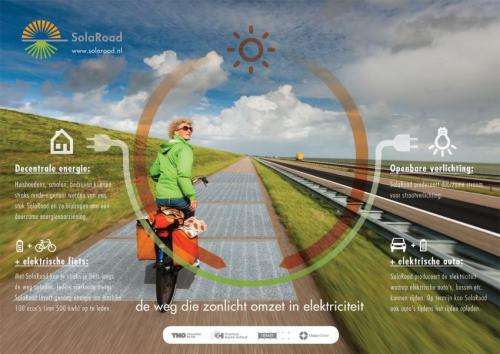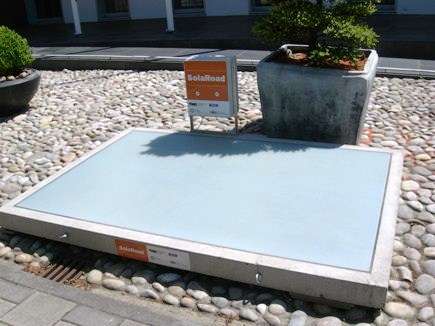Imtech, in conjunction with the Province of Noord-Holland, Ooms Civiel, has developed the world's first solar road located in Krommwnie, Holland. The solar cycle path will be connected to the national grid to meet increasing energy demands and to advance of renewable energy use in Holland. It will be open to the public on Wednesday the 12th November.
The local authority-funded pilot scheme costing €3m ($3.7m) "SolaRoad" pilot cycle path is constructed with two lanes, one of which is made of prefabricated concrete slabs connected to the national grid. One lane is made of 2.5 by 3.5 meter slabs of concrete with an integrated layer of crystalline silicon solar cells and has a top layer of translucent, tempered safety glass (~1cm thick). The second lane, constructed without solar cells, will be used for testing various top surfaces.
Crystalline solar cells are made with two 'doped' semiconductors . Doping is the addition of an impurity to the silicone. Impurities in the silicone of the n-type semiconductor create mobile free electrons. In the p-type semiconductor, the impurities create holes. Where the n and p-type layer meet (called the junction), electrons cross the junction and join with a hole, cancelling each other out, leaving a positive charge in the n-type. The holes also move across the junction from the p-type region to the n-type, leaving a negative charge. The movement of electrons across the p-n junction creates a built-in electric field that is always present across the cell. When photons from the sun strike the solar cell, there is a release of electrons from the junction back to the n-type semiconductor and holes back to the p-type semiconductor. The resulting separation and consequently fluctuation of positive and negative charges across the junction creates a potential difference or voltage .
Over the course of the three-year testing period, the team aims to collect data and research about a number of factors that could influence the project moving forward. In addition to lab-based experimentation, various aspects of the road will be researched and calibrated. Namely, research for the optimisation of the information and communication technology (ICT) largely responsible for power distribution, particularly at maximal (peak sunlight) and minimal (night) times, top layer research (e.g. effects of pollution and wear) and the possibility of integrating other solar energy technologies like thin-film solar cells.
Even though the single-lane path produces less than 30 percent less energy than rooftop solar panels, researchers hope that the SolaRoad will utilise up to 20 percent of the 140,000km roadway for renewable energy generation, vastly increasing the surface area that could be achieved with rooftop solar panels. The short stretch of road is expected to generate enough electricity to power 2 or 3 average homes annually. Future projects aim at developing road surfaces to combine with a Road Energy Systems product, also developed by Ooms Civiel, that is designed to extract heat from asphalt surfaces.
More information: www.solaroad.nl/en/
© 2014 TechExplore
























